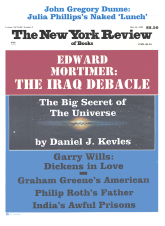In response to:
A Phony Ancestor from the November 8, 1990 issue
To the Editors:
May I suggest a text which perhaps corroborates Lord Zuckerman’s belief that the jawbone of Piltdown Man was “planted” by Martin Hinton as a hoax [“A Phony Ancestor,” NYR, November 8, 1990].
In E. Nesbit’s The Would-be-Goods, the Bastable children are inspired to arrange just such a “sell” for the Maidstone Society of Antiquaries excavating a nearby barrow. The children bury old metal and mud pots of their own manufacture for the Antiquaries to find; Alice and Oswald also bury a pair of old “jugs” which Alice takes from the library. These, however, are real Roman pottery and are borne off triumphantly by the President of the Society. Of course, the children’s mud vessels are recognized for what they are and cause much antiquarian laughter.
But, in order to retrieve the real Roman pots, Alice has to identify them by the words she wrote inside each. The first pot says, “Sucks,” and the second, “Sold again, silly.” Given Hinton’s interest in hoaxes, may not a memory (conscious or subliminal) of the Bastables’ prank been his model? Furthermore, the Bastables took the idea from Charlotte M. Yonge’s The Daisy Chain, where children “salt” a dig at a Roman camp with home-made pottery which the finders accept as genuine.
Parts of The Would-be-Goods were published in periodicals from 1900 to 1901, and it was issued in book form in 1901—just when Martin Hinton would be at the age to read it; in fact, it would have been difficult for a reading child at the turn of the century to escape E. Nesbit! How much simpler anthropology would have been, had Hinton only written, “Sold again, silly,” on the jawbone Lord Zuckerman says was designed for Sir Arthur Smith Woodward.
Jane W. Stedman
Professor Emeritus of English
Roosevelt University
Chicago, Illinois
Lord Zuckerman replies:
I am grateful to Professor Jane Stedman for drawing my attention to E. Nesbit’s book, and am amused by the suggestion that the story it tells provides a parallel to the Piltdown hoax. Another possible parallel is the story of the Sherborne horse, to which Dr. Spenser refers on p. 170 of his book.
One day in 1911 two boys at Sherborne School in Dorset presented their science master, a Mr. Elliott Steel, with a piece of old bone—a rib—on which was scratched the head of a horse that bore a canny resemblance to one that was engraved on a well-known piece of fossil rib that had been discovered in the 1870s by Boyd Dawkins, a celebrated fossil and stone-implement hunter of those days. Mr. Steel sent it to Smith Woodward, who in 1914 published a short paper about the find in the Geological Society’s Journal (Q.J. Geological Society of London, 1914, Vol. 70, pp. 100–101). In 1924 Sollas, in a new edition of his book, Ancient Hunters, declared that the Sherborne specimen was a fraud, basing his opinion mainly on a presumed confession by the boys that they had done what they did in order to fool their master. Two years later Smith Woodward countered William J. Sollas in a brief letter to Nature (Vol. 117, 1926, p. 86), in which he merely reaffirmed his view that the bone was genuine, at the same time as he reported that he had made a search in the quarry where the boys said they had found their specimen, but without finding any related bones.
There the matter rested, with many accepting Sollas’s view that the Sherborne horse was a hoax, until it was taken up in 1979 by R.A.H. Farrar in a paper, to which was appended a note by Kenneth Oakley, who had measured the concentration of fluorine, uranium, and other chemicals in the specimen, with results which indicated that it was a true fossil (Antiquity, Vol. 53, 1979, pp. 211–216). A year later Mr. Farrar’s view that the engraving had been made when the bone was fresh, and that the specimen was paleolithic in age, was challenged in a note to Nature by Dr. Ann Sieveking, a researcher in paleolithic art at the London Institute of Archaeology. Her comments added up to the conclusion that while the bone may have been fossilized, the engraving had not been made when the bone was fresh, and that in detail the drawing was uncharacteristic of paleolithic work (Nature, Vol. 282, 1980, pp. 719–720). A year later (Antiquity, Vol. 55, 1981, pp. 44–46), Mr. Farrar reaffirmed his own view, which was backed by Miss Theya Molleson of the Natural History Museum in a brief note that did not question Dr. Sieveking’s opinion about the finer points of Palaeolithic art, but questioned her observations about the nature of the incised lines, an opinion which Dr. Sieveking dismissed in a later article. And there, to the best of my knowledge, the matter now rests.
Whether the Sherborne boys found a true paleolithic fossil, or whether they had emulated Nesbit’s Bastable children, will I hope be the subject of a future contribution to the debate.
This Issue
May 16, 1991



